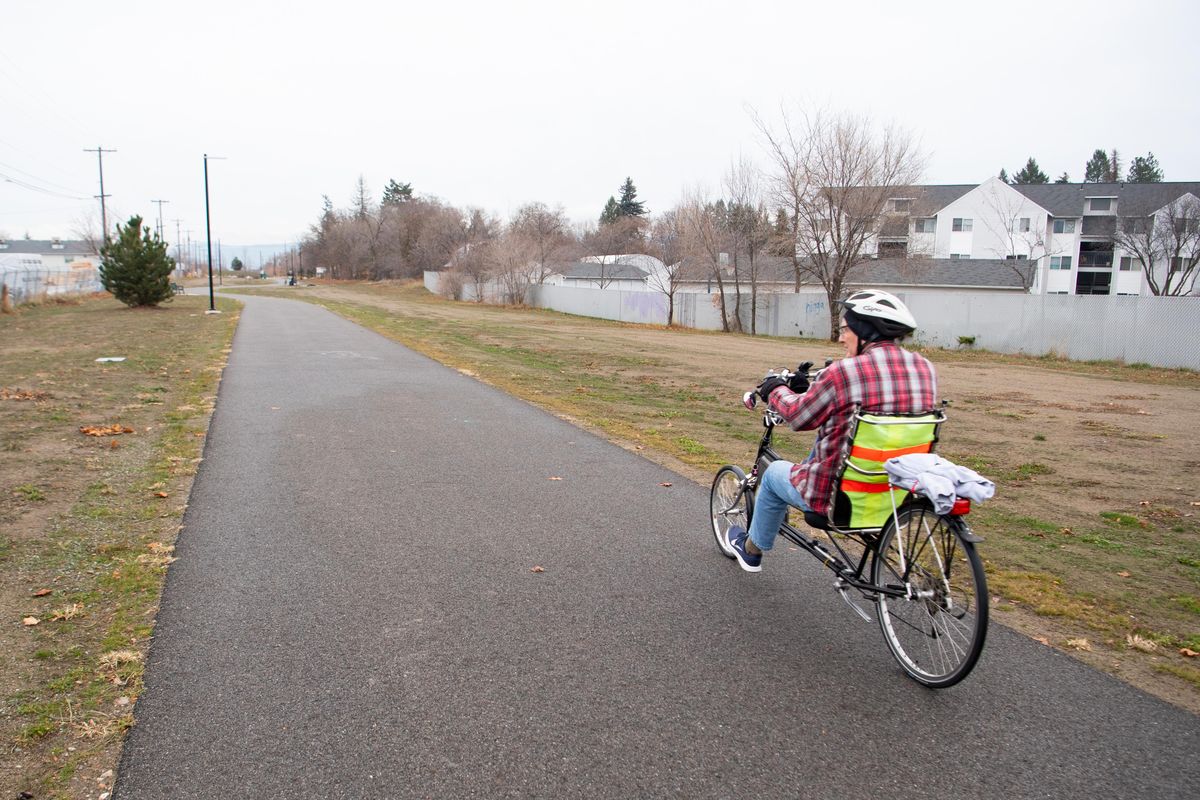As city starts last section of Appleway Trail, leaders hope it will bind Spokane Valley together

On a day when few others were willing to brave the cold November temperatures, Anthony Gates sat bundled in a coat and sweatshirt on a new green park bench with a friend and a bag of refreshments near the entrance to the Appleway Trail.
Gates was there to walk the trail and improve his cardio, but he said the trail has other benefits too. It makes him feel connected to the community and provides a good place to be outside on his days off from his job as a chef, he said.
Gates, who grew up in Chicago but now lives nearby, said Spokane Valley has turned into a city, though it doesn’t have the “crime, grime and slime” he grew up with.
“I’ve heard people get down on the Valley,” he said. “But you’ve got to start somewhere, and it’s growing.”
When he first moved to Spokane Valley in the 1990s, the area that has now become a trail was mostly farmland or covered with sagebrush.

Evidence of the rapid change can be seen as the trail winds its way past warehouses, department stores and industry on one side and past apartments, old Spokane Valley homes and an occasional pasture on the other.
The city broke ground on the first section of the trail in 2014 and the last section earliert his month. When complete, hopefully next summer, it will connect two disjointed segments into a 5.1-mile trail that will be more like a “linear park” and that will link Balfour Park, City Hall and Liberty Lake.
Spokane Valley doesn’t have a traditional downtown, and Mayor Rod Higgins said it may never. Currently, the city has several centers spread out and the trail is designed to give residents a common place where the community could gather.
“It will help us bind the city together,” Higgins said. “It’s a string from one end to the other.”
Andrew Gebhart, who walked with a bag full of textbooks under his arm, said he uses the trail to walk to his job as an ESL instructor at Spokane Community College.
Gebhart, who moved from the West Plains to Spokane Valley about six months ago, said walking helps him use less gas and the trail helps him avoid Sprague Avenue, which is as wide as seven lanes in some sections.
His previous home was close to the Fish Lake Trail, and when moving to the Valley, he was hoping for a neighborhood where he could walk to work. While the Appleway Trail isn’t as scenic as Fish Lake, he said it’s better than being surrounded by traffic.
“I can’t wait for them to finish it,” he said.
He hopes the final product will connect the region, and Balfour Park, the library and City Hall. He also hopes the senior center, now in CenterPlace, might also move to the library, making life more convenient for the people who may need to use those resources.
Higgins said the current trail is a “rough draft” of what it will eventually be. Park staff recently replanted grass that needs very little water, and there are young trees and light posts spread throughout.
Spokane Valley Parks Director Mike Stone said the city still needs to hire a consultant to solidify the park’s theme, which will reflect the region’s history, and develop a master plan so the city can apply for more grants to improve the park.
Once a theme and master plan are solidified, he said the city could start adding features such as picnic shelters, play equipment, informational displays and sculptures.
He said there are also several vacant properties along the trail that the city could someday buy and turn into parklets.
“The possibilities really are endless,” Stone said.
Dean Grafos, a former Spokane Valley mayor, said he proposed the trail after he and former County Commissioner Mark Richard were getting coffee near what is now the University Road trailhead and he noticed people walking through the weeds that had taken over the Milwaukee Railroad right of way.
The city secured the Milwaukee’s right of way through an agreement with Spokane County in 2012 and has been adding sections of trail and amenities in the years since. Grafos said the trail made the area more attractive to families and was a way for the young city to have a unique feature of its own.
“It was important for the city to have its own identity,” Grafos said.